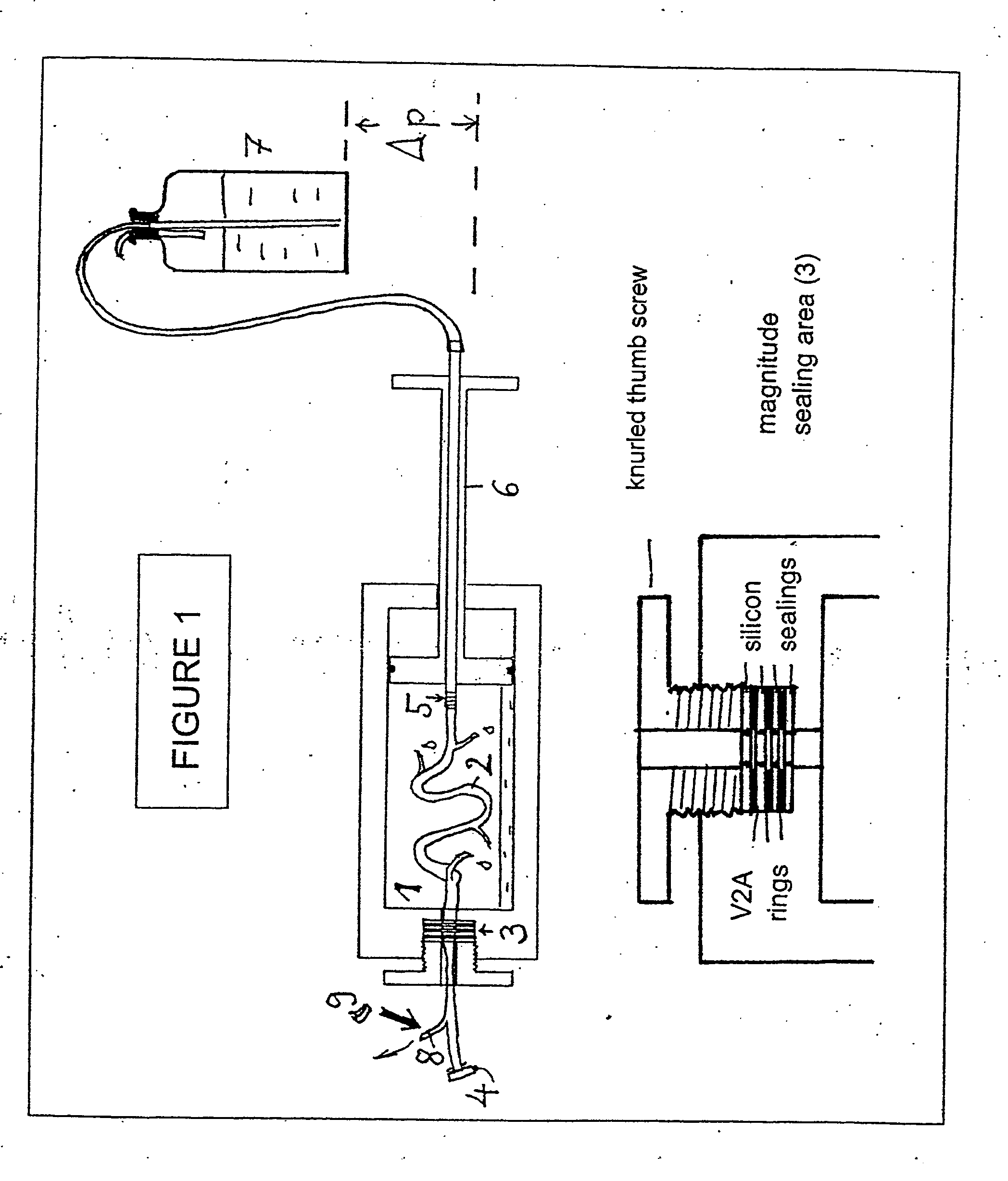Methods And Apparatus For Preserving The Endothelium In Isolated Hollow Organs And Biological Vessels
a technology for endothelium and biological vessels, applied in the field of methods and apparatus for treating and preserving endothelium in isolated hollow organs, can solve the problems of remarkable damage to endothelium function, autologous vascular substitutes often not providing satisfying transplant results, and significant loss of functions, so as to prevent ablation or destruction of endothelium and infiltrate into very small vessels and vascular segments.
- Summary
- Abstract
- Description
- Claims
- Application Information
AI Technical Summary
Benefits of technology
Problems solved by technology
Method used
Image
Examples
example 1
Preferred Method for Endothelium-Preserving Treatment of Isolated Hollow Organs or Biological Vessels
[0205] In one embodiment of the method of the invention, a perfusion solution with the following composition was used when blood vessels were to be treated:
[0206] Physiological electrolyte solution with 127 mM NaCl; 4.6 mM KCl; 1.1 mM MgSO4; 1.2 mM KH2PO4; 24 mM histidin-Cl; 2 mM CaCl2. Prior to addition of CaCl2 the pH value of the solution was adjusted under atmospheric conditions at pH=7.40. Further, the perfusion solution contained a 10 vol-% lipoprotein-free, hemolysin-free, homologous serum preparation from a pool of blood preparations (obtained from healthy donors), 2.5 mM L-glutamine, 2 mM Na-pyruvate, 8 mM glucose, 200 U / ml penicillin and 0.2 mg / ml streptomycin, low molecular heparin (fraxiparin purchased from Pharmacia Ltd.: 100 μl / 100 ml complete solution) and, in addition, 50 μM of each of uric acid and ascorbate.
[0207] In the method for endothelium-preserving treatmen...
example 2
Regeneration of Endothelial Tissue from Vena Saphena by Treatment a with One Embodiment of the Endothelium-Preserving Perfusion Solution
[0208] In order to demonstrate the efficiency of the endothelium-protective perfusion solution and the method of the invention, isolated endothelial cells obtained from human Vena saphena were microscopically observed during incubation with different embodiments of the perfusion solution of the invention following treatment of the cells and the efficiency was documented by serial or video time-lapse microphotography.
[0209] Endothelial cells from non-required rest pieces of human Vena saphena were selectively removed by collagenase incubation and grown in minimal essential medium (e.g. “Dulbecco minimal essential medium”, DMEM) containing 10% v / v fetal calf serum under water vapor-saturated atmospheric environment under addition of 5% v / v carbon dioxide at a temperature of 37° C. (“incubator conditions”) until confluence. Then, the selected plates ...
example 3
Preferred Perfusion Solution or Incubation Solution which Includes Quercetin
[0220] In the following example, the effect of quercetin, a naturally occurring anti-inflammatory-acting flavonoid on the endothelium of the smallest body vein (venules) was investigated in detail (see FIG. 5). To do this, different isolated human hearts of donors were rinsed thoroughly in the presence and absence of quercetin. This solution had the following composition: Isotonic electrolyte solution (127 mM NaCl; 4.6 mM KCl; 1.1 mM MgSO4; 1.2 mM KH2PO4; 24 mM histidin-Cl; 2 mM CaCl2 (pH to 7.40 prior to addition of CaCl2); 0.1% albumin and 2.5 mM L-glutamine. The perfusion solution also contained: 2 mM Na-pyruvate, 8 mM glucose, 200 U / ml penicillin and 0.2 mg / ml streptomycin, low molecular heparin (fraxiparin from Pharmacia Ltd.: 100 μl / 100 ml complete solution) and, in addition, 100 μM freshly added quercetin.
[0221] For the investigation of myocardial arteries and venules (which are particularly effecte...
PUM
 Login to View More
Login to View More Abstract
Description
Claims
Application Information
 Login to View More
Login to View More - R&D
- Intellectual Property
- Life Sciences
- Materials
- Tech Scout
- Unparalleled Data Quality
- Higher Quality Content
- 60% Fewer Hallucinations
Browse by: Latest US Patents, China's latest patents, Technical Efficacy Thesaurus, Application Domain, Technology Topic, Popular Technical Reports.
© 2025 PatSnap. All rights reserved.Legal|Privacy policy|Modern Slavery Act Transparency Statement|Sitemap|About US| Contact US: help@patsnap.com



